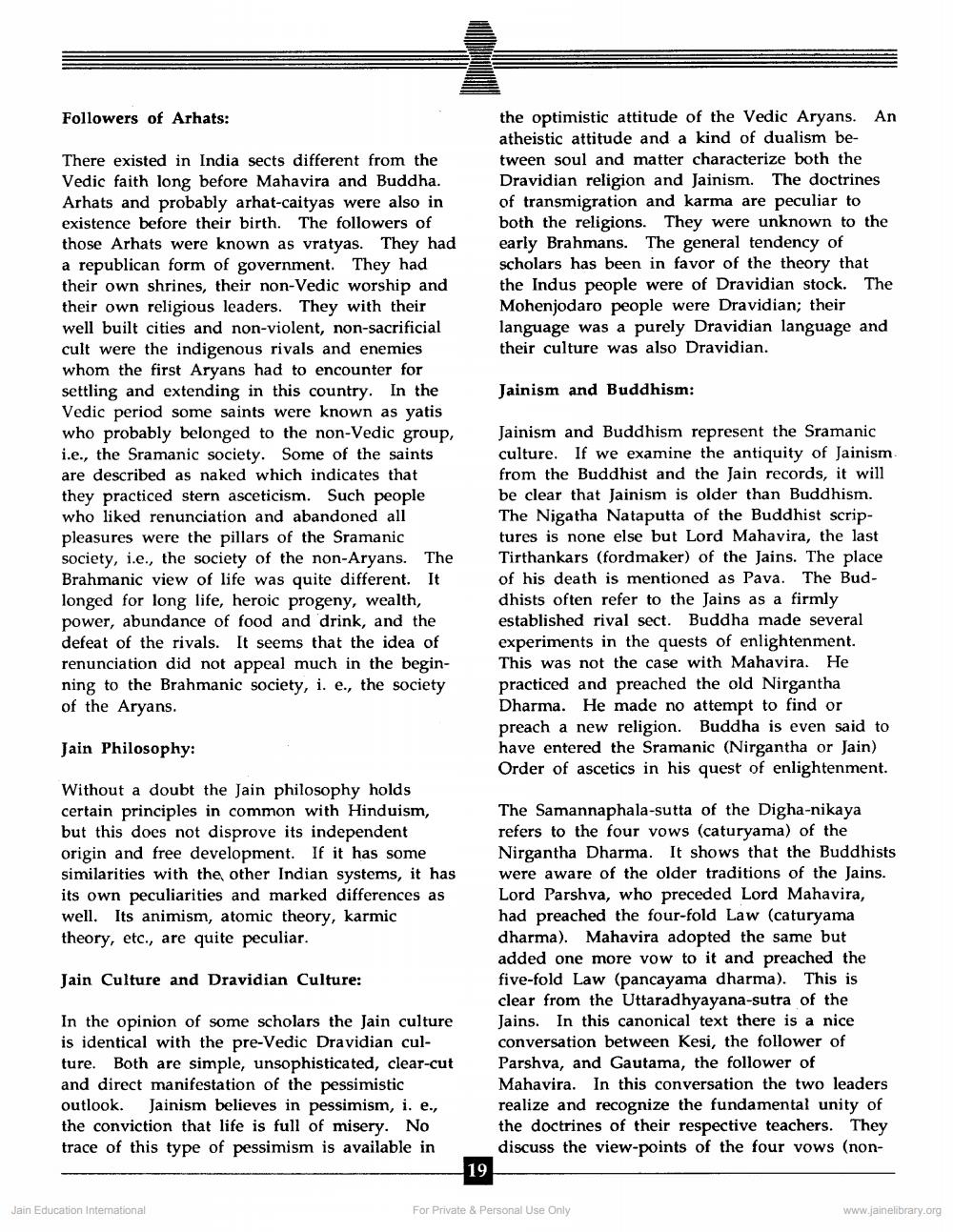________________
Followers of Arhats:
the optimistic attitude of the Vedic Aryans. An atheistic attitude and a kind of dualism between soul and matter characterize both the Dravidian religion and Jainism. The doctrines of transmigration and karma are peculiar to both the religions. They were unknown to the early Brahmans. The general tendency of scholars has been in favor of the theory that the Indus people were of Dravidian stock. The Mohenjodaro people were Dravidian; their language was a purely Dravidian language and their culture was also Dravidian.
Jainism and Buddhism:
There existed in India sects different from the Vedic faith long before Mahavira and Buddha. Arhats and probably arhat-caityas were also in existence before their birth. The followers of those Arhats were known as vratyas. They had a republican form of government. They had their own shrines, their non-Vedic worship and their own religious leaders. They with their well built cities and non-violent, non-sacrificial cult were the indigenous rivals and enemies whom the first Aryans had to encounter for settling and extending in this country. In the Vedic period some saints were known as yatis who probably belonged to the non-Vedic group, i.e., the Sramanic society. Some of the saints are described as naked which indicates that they practiced stern asceticism. Such people who liked renunciation and abandoned all pleasures were the pillars of the Sramanic society, i.e., the society of the non-Aryans. The Brahmanic view of life was quite different. It longed for long life, heroic progeny, wealth, power, abundance of food and drink, and the defeat of the rivals. It seems that the idea of renunciation did not appeal much in the beginning to the Brahmanic society, i. e., the society of the Aryans.
Jainism and Buddhism represent the Sramanic culture. If we examine the antiquity of Jainism from the Buddhist and the Jain records, it will be clear that Jainism is older than Buddhism. The Nigatha Nataputta of the Buddhist scriptures is none else but Lord Mahavira, the last Tirthankars (fordmaker) of the Jains. The place of his death is mentioned as Pava. The Buddhists often refer to the Jains as a firmly established rival sect. Buddha made several experiments in the quests of enlightenment. This was not the case with Mahavira. He practiced and preached the old Nirgantha Dharma. He made no attempt to find or preach a new religion. Buddha is even said to have entered the Sramanic (Nirgantha or Jain) Order of ascetics in his quest of enlightenment.
Jain Philosophy:
Without a doubt the Jain philosophy holds certain principles in common with Hinduism, but this does not disprove its independent origin and free development. If it has some similarities with the other Indian systems, it has its own peculiarities and marked differences as well. Its animism, atomic theory, karmic theory, etc., are quite peculiar.
Jain Culture and Dravidian Culture:
The Samannaphala-sutta of the Digha-nikaya refers to the four vows (caturyama) of the Nirgantha Dharma. It shows that the Buddhists were aware of the older traditions of the Jains. Lord Parshva, who preceded Lord Mahavira, had preached the four-fold Law (caturyama dharma). Mahavira adopted the same but added one more vow to it and preached the five-fold Law (pancayama dharma). This is clear from the Uttaradhyayana-sutra of the Jains. In this canonical text there is a nice conversation between Kesi, the follower of Parshva, and Gautama, the follower of Mahavira. In this conversation the two leaders realize and recognize the fundamental unity of the doctrines of their respective teachers. They discuss the view-points of the four vows (non
In the opinion of some scholars the Jain culture is identical with the pre-Vedic Dravidian culture. Both are simple, unsophisticated, clear-cut and direct manifestation of the pessimistic outlook. Jainism believes in pessimism, i. e., the conviction that life is full of misery. No trace of this type of pessimism is available in
19
Jain Education Intemational
For Private & Personal Use Only
www.jainelibrary.org




